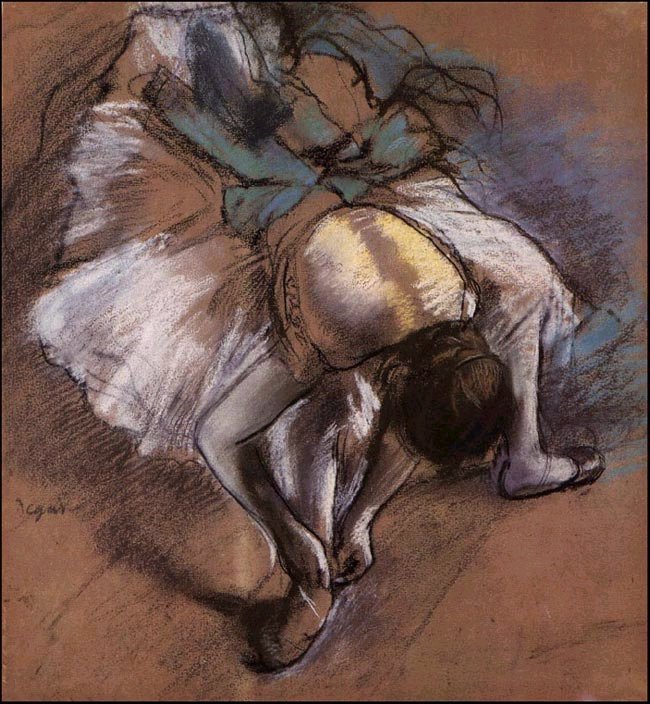There are several stages in understanding Degas’ oeuvre. At first, you think he was a connoisseur of delicate beauty (otherwise why did he constantly paint ballerinas?)
Then you find different reproductions of his pictures, scrutinize them, and wonder: his ballerinas seem to be deliberately depicted in the most inelegant poses! They are adjusting their slippers, scratching themselves, or rubbing their ankles. You also discover another of Degas’ favorite subjects – naked women grooming themselves like animals. Maybe he hated women?! What a scoundrel!
Please do not stop at this stage.
A Label of Misogynist
Edgar Degas was unlucky to get into the number of the geniuses whose legacy is now being re-evaluated by the standards of modern morality.
Many researchers cannot forgive him for his conservative social views, quite typical of a well-off person in the 19th century, and the strange words he tended to use to describe his models.
The art historian John Richardson categorically calls Degas a “misogynist in a misogynistic society”. (1) Writing about Degas and the dancers whom he painted, Richardson asserts:
He was not interested in capturing their onstage prettiness. He wanted to portray his “little monkey girls” under stress, “cracking their joints” at the barre, as he said, their youthful spirits crushed, their muscles in agony, their feet raw and bleeding.
Indeed, Degas was more or less indifferent to the charm of ballerinas; he willingly drew and painted these girls in minutes that were psychologically difficult for them.
It’s probably also true that “he sometimes obliged the dancers who modeled for him in the studio to pose for hours on end—legs extended or bent, arms held high overhead—in excruciating discomfort, even for dancers inured to pain.” (1)
But what I’m sure of is that Edgar Degas did not mock anybody because of his cruelty. He was simply obsessed with his work.
People who write on art often mention the fact that Degas never married and consider that as a bad sign.
“Degas was a lifelong bachelor,” – Rain Embuscado, a culture reporter, reasons, “As for why he was such a bachelor? Well, perhaps it had something to do with him equating women with racehorses.”
In my opinion, the marital status of any person is not a reason to draw far-reaching conclusions about him or her. I (and probably you) could list dozens of very good people, who live alone.
And, for that matter, we should take into account the memories left by contemporaries of Degas. Georges Rivière, who met the artist around 1875, remarked (2):
He, who often depicted them with real cruelty, derived great pleasure from being with them, enjoyed their conversation, and produced pleasing phrases for them.
Apparently, Edgar Degas simply separated his work and personal life. In his free time, Degas enjoyed the communication with women and was gallant; but as soon as he took up a brush or pastel, he became a skeptical observer incapable of polite flattery.
And let’s already give the floor tо Degas’ pictures. They definitely can stand up for their creator.
Little Monkey Girls
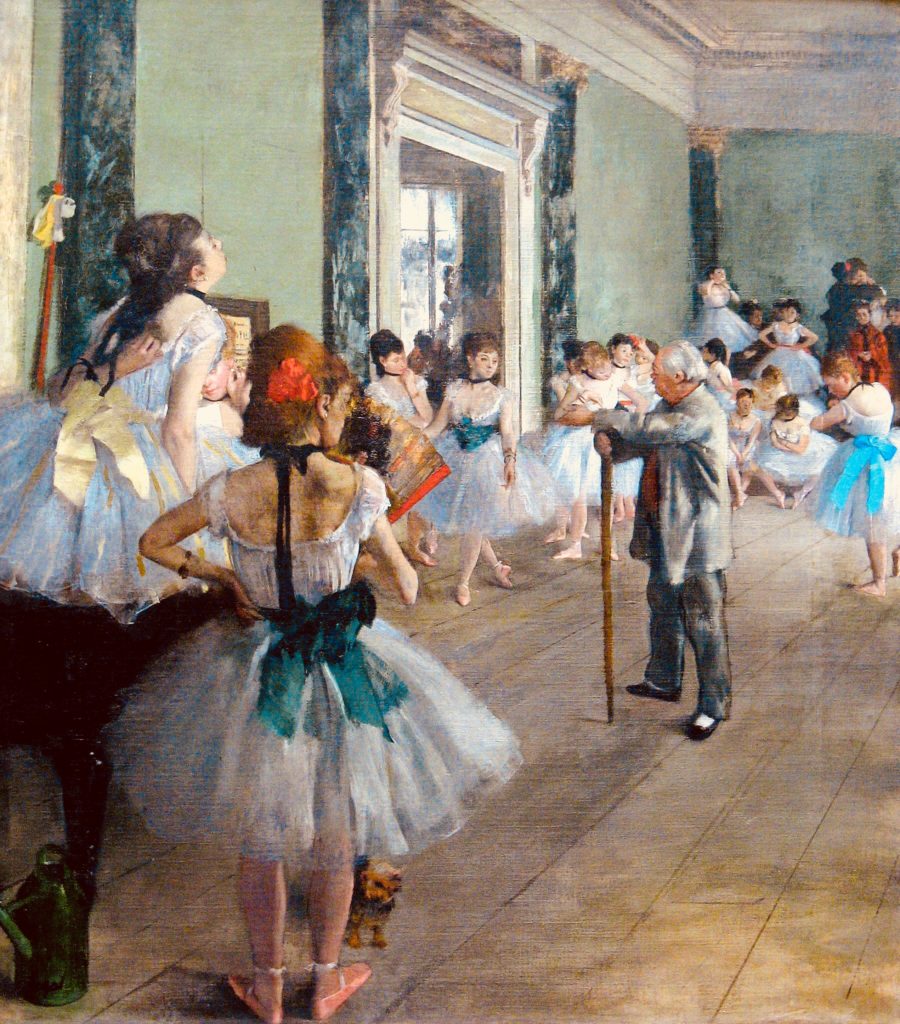
What I regret is that I do not have the opportunity to show you this painting itself instead of its reproduction. The skill of the artist is amazing: The Dance Class – a compositionally complex multi-figure painting – is surprisingly small (85.5. x 75 cm).
Degas juxtaposes vacant spaces and figures, crops them, and overlays them with one another. Creating the seeming chaos, the painter captures the moment, ordinary and unrepeatable at once.
The artist painstakingly conveys all the details of the scene he’s watching. Here is a tiny dog who does not know where to go – the pooch’s paws could be stepped on at any time. In the corner, there is a watering can – such cans were used to wet floors that were too slippery.
A dancer with red hair, sharp elbows, and protruding shoulder blades is absent-mindedly listening to the choreographer, the ballerina having perched on the piano twisted to scratch her back – she is frankly bored. The dancers in the background are also killing time – they are talking to each other. These girls bear little resemblance to the inspired votaries of Terpsichore.
The artist is not prejudiced, but simply honest. By the moment Degas turned his attention to French ballet, it “sunk to the level of kitschy interludes in operas” and “could hardly be considered an art form”. (1) The career of a ballerina was just a modest alternative to the job of a laundress or a prostitute.
Many girls entered the ballet class just out of poverty; they were completely apathetic about what they were supposed to do.
Two Parisian Laundresses as They Are

Two laundresses are busy with hard physical labor (back then, an iron could weigh 5–10 kg). While one of them continues to work, the second is yawning with fatigue.
Degas’ approach contrasts greatly with that of the artists who turned to portraying the poor in the last decades of the 19th century. To make sure of this, have a look at a painting by the Russian artist Abram Arkhipov:
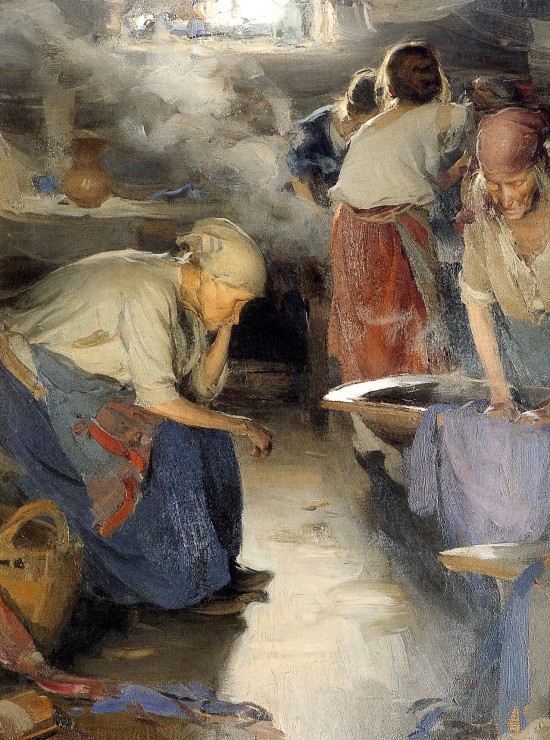
Arkhipov’s laundresses are the miserable, from whom labor has sucked all life; Degas’s ironing women are neither old nor emaciated.
He captured exactly what he sees, his true impression – it is not ot surprising that he is called an impressionist. However, it should be highlighted that, unlike Monet or Renoir, Edgar Degas usually preferred working in the studio from preparatory drawings to painting directly on location.
He studied every subject carefully. His friends (in particular, Edmond de Goncourt) reminisced: drawing washerwomen, he delved into all their techniques, he understood when and why they ironed with pressure or in a circle.
Was he concerned about social injustice – the circumstances in which some people can afford any luxury, while others are deprived of the essentials? I don’t think so.
The real focus of Degas’ artistic interest was the way his models behaved. After all, he was an artist, not a human rights activist.
A Nude in the Style of Degas
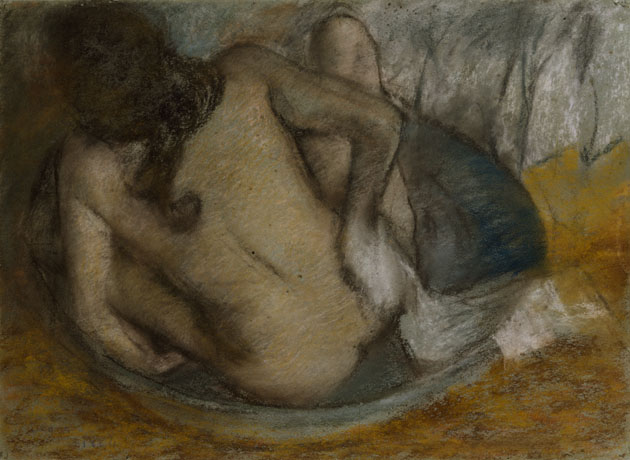
The naked woman depicted in the pastel above is young and slender. Most artists from Degas’ epoch would have depicted this model as a beautiful Venus surrounded by plump cupids.
Take a look at the painting by Alexandre Cabanel for comparison:
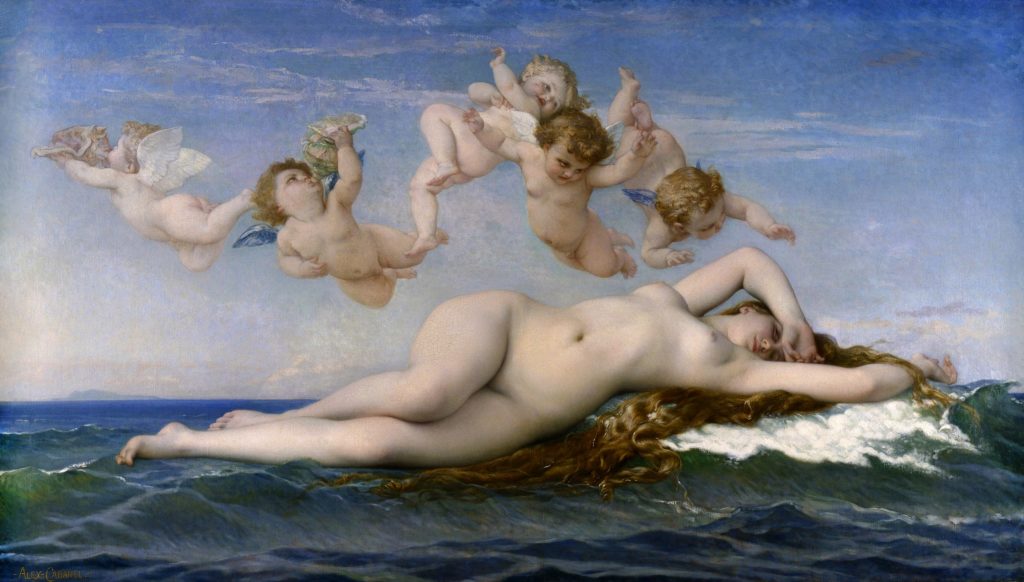
Alexandre Cabanel, The Birth of Venus
Edgar Degas portrays her sitting in a tub and absorbedly rubbing that part of the body that is not accepted to be mentioned in decent society. The bather’s pose should appear unpleasant; however, let’s forget about stereotypes and admit: there is nothing disgusting about it.
Degas’ impeccable line conveys an amazing naturalness and ease of the woman’s moves.
If we think for a moment, we will recognize: Degas treats his models far more respectfully than his colleagues, who specialized in immortalizing seductive venuses, treated theirs. He depicts women without any sexual undercurrents.
In Edgar Degas’ lifetime, art critics often laughed at his bathers but praised artists like Cabanel. Nowadays, Cabanel is almost forgotten; Degas is incredibly famous. Unfortunately, it doesn’t mean we are ready to correctly interpret his works and biography.
“I want to be famous but unknown!” – he once said, as if he had a presentiment of what his posthumous future would be.
- Degas and the Dancers – John Richardson, Vanity Fair, May 18, 2009
- Feminism And Art History – Questioning The Litany – Norma Broude, Mary Garrard, Avalon Publishing, 1982
- Degas: Agency in Images of Women – Emma Wolin. Valley Humanities Review Spring 2013
- Degas’s “Misogyny” – Norma Broude, The Art Bulletin Vol. 59, No. 1 (Mar., 1977)
